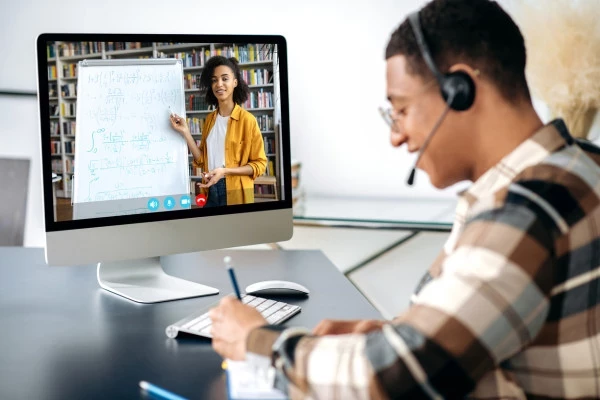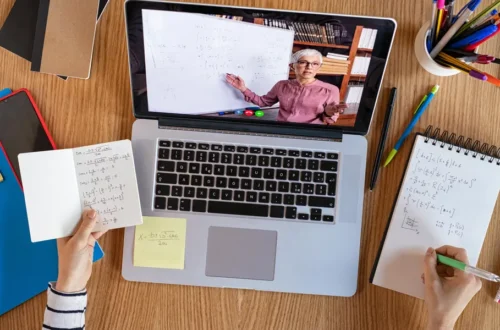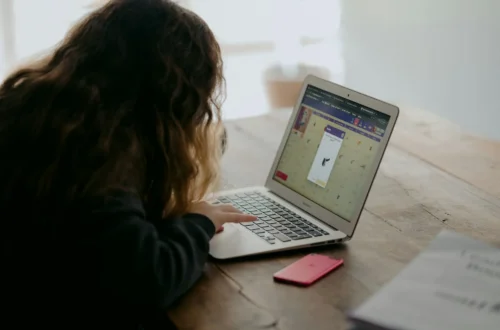Education has transformed dramatically in recent years, and choosing between in-person and online learning is a decision many students face. I remember sitting in a bustling college lecture hall, scribbling notes as my professor’s chalk squeaked across the board, and later, years into my career, logging into a virtual classroom from my kitchen table, juggling work and family life. Both experiences taught me something unique, but they also came with their own sets of challenges. This article dives deep into the pros and cons of in-person and online learning, helping you decide which path best suits your needs, lifestyle, and goals.
What Is In-Person Learning?
In-person learning involves face-to-face instruction in a physical classroom, where students and teachers interact in real-time. Think of traditional school settings—rows of desks, a teacher at the front, and the hum of group discussions.
This classic model thrives on direct engagement and structured schedules, fostering a sense of community. It’s the go-to for hands-on subjects like lab sciences or art classes, but it’s not without its limitations.
Why Choose In-Person Learning?
In-person learning offers a tangible experience that’s hard to replicate. The energy of a classroom, the spontaneous debates, and the ability to ask questions on the spot create a dynamic environment. For many, it’s the gold standard for building connections and staying focused.
What Is Online Learning?
Online learning, often called e-learning or distance education, takes place over the internet, either synchronously (live sessions) or asynchronously (pre-recorded content). It’s gained traction since the pandemic, with platforms like Coursera, Zoom, and Google Classroom leading the charge.
This format allows students to learn from anywhere, at their own pace, making it ideal for those with busy schedules. However, it demands discipline and a reliable internet connection.
Why Choose Online Learning?
Online learning is a game-changer for flexibility. Whether you’re a working parent or a student in a remote area, it removes barriers like commuting or rigid class times. It’s also often more affordable, but it requires you to stay motivated without a teacher hovering nearby.
Pros of In-Person Learning
In-person learning has been the backbone of education for centuries, and for good reason. It’s immersive, interactive, and often more engaging for certain learners. Here are the key advantages:
- Direct Interaction: Face-to-face communication with instructors allows for immediate feedback and clarification, which is invaluable for complex topics.
- Structured Environment: Fixed schedules and dedicated classrooms reduce distractions, helping students stay focused. No Netflix tempting you in the background!
- Social Connections: Building relationships with peers fosters collaboration and a sense of community, which can boost motivation.
- Hands-On Opportunities: Subjects like chemistry, engineering, or performing arts thrive in physical settings with access to labs, equipment, or studios.
- Accountability: The routine of attending classes in person encourages discipline, especially for those who struggle with self-motivation.
Real-World Example: The Power of Presence
I once took a pottery class in person, and the instructor’s hands-on guidance—literally adjusting my fingers on the clay—made all the difference. That kind of tactile feedback is tough to replicate online, where you’re often left to troubleshoot alone.
Cons of In-Person Learning
Despite its strengths, in-person learning isn’t perfect. It can be restrictive and costly, especially in today’s fast-paced world. Here’s what to consider:
- Limited Flexibility: Fixed schedules mean you’re locked into specific times and locations, which can clash with work or family responsibilities.
- Higher Costs: Tuition, commuting, housing, and meal plans add up. A 2023 report found in-person degrees can cost up to $185,252 at private institutions, compared to $60,593 for online degrees.
- Geographic Barriers: If you live far from a quality institution, access can be a challenge, especially for specialized programs.
- Disruptions: Weather, pandemics, or other unforeseen events can halt in-person classes, as we saw during COVID-19.
A Personal Hurdle
When I was in college, a snowstorm shut down my campus for a week, leaving me scrambling to catch up. Online learning, by contrast, would’ve kept things moving without missing a beat.
Pros of Online Learning
Online learning has exploded in popularity, with 98% of universities offering online courses since 2020. Its appeal lies in accessibility and affordability. Here are the top benefits:
- Flexibility: Learn at your own pace, on your own schedule. Perfect for night owls or those balancing multiple responsibilities.
- Cost-Effective: Online programs often have lower tuition, and you save on commuting, housing, and other expenses. Some platforms, like YouTube, even offer free courses.
- Accessibility: No geographic limits—students from rural areas or different countries can access top-tier education.
- Diverse Networking: Connect with peers worldwide, broadening perspectives and professional opportunities. Forbes notes online classes often enroll more diverse students.
- Personalized Pace: Rewatch lectures, pause videos, or speed through content, tailoring the experience to your learning style.
A Success Story
A friend of mine, a single mom, earned her business degree online through the University of the People while working full-time. The flexibility allowed her to study after her kids were asleep, something in-person classes couldn’t offer.
Cons of Online Learning
Online learning isn’t a one-size-fits-all solution. It comes with challenges that can make or break the experience. Here’s what to watch out for:
- Lack of Interaction: Limited face-to-face engagement can lead to feelings of isolation, reducing collaboration and networking opportunities.
- Self-Discipline Required: Without a set schedule, procrastination can creep in. You need strong motivation to stay on track.
- Technical Issues: A shaky internet connection or outdated device can disrupt learning. 15% of U.S. households with school-age kids lack high-speed internet.
- Distractions at Home: Studying from your couch sounds great until the dog starts barking or your roommate blasts music.
- Limited Hands-On Learning: Subjects requiring labs or physical practice, like nursing or welding, are harder to teach online.
My Own Struggle
I once tried an online coding course, but my spotty Wi-Fi turned every live session into a buffering nightmare. It was a reminder that tech isn’t always your friend.
Comparing In-Person and Online Learning: A Side-by-Side Look
To make your decision easier, here’s a concise comparison of key factors:
| Feature | In-Person Learning | Online Learning |
|---|---|---|
| Flexibility | Fixed schedules, less control | High flexibility, self-paced |
| Cost | Higher (tuition, commuting, housing) | Lower (no commuting, often cheaper tuition) |
| Interaction | Direct, face-to-face with peers and instructors | Limited, mostly virtual |
| Accessibility | Limited by location | Global access, inclusive for diverse learners |
| Engagement | Structured, fewer distractions | Requires self-discipline, potential distractions |
| Hands-On Learning | Ideal for labs, practical skills | Limited for hands-on subjects |
This table highlights that neither option is inherently “better”—it depends on your priorities, learning style, and circumstances.
Blended Learning: The Best of Both Worlds?
If you’re torn between the two, blended learning might be your answer. This hybrid approach combines in-person and online elements, offering flexibility while maintaining some face-to-face interaction. For example, a “flipped classroom” model lets you study theory online and use class time for discussions or hands-on activities.
Studies show blended learning boosts engagement and satisfaction by balancing structure and flexibility. It’s perfect for those who want the best of both worlds but requires institutions to offer this option.
A Real-Life Blend
My cousin’s MBA program used a blended model—online lectures during the week and in-person workshops on weekends. She loved the flexibility but still got to network with classmates in person, which landed her a job through a connection she made.
People Also Ask (PAA) Section
Here are real questions from Google’s PAA, answered concisely to align with search intent:
Is online learning as effective as in-person learning?
Research shows online learning can be as effective as in-person learning, with studies indicating comparable outcomes for knowledge retention and performance. However, effectiveness depends on engagement and self-discipline.
What are the main advantages of in-person learning?
In-person learning offers direct interaction, immediate feedback, a distraction-free environment, and hands-on opportunities, making it ideal for collaborative and practical subjects.
Can online learning replace in-person learning?
Online learning can complement but not fully replace in-person learning, especially for fields requiring physical practice. Blended learning often provides the best balance.
How do I stay motivated in online classes?
Set a consistent schedule, create a distraction-free study space, and engage with peers through discussion boards or virtual study groups to stay motivated.
Where to Get In-Person and Online Learning Resources
- In-Person Learning: Check local universities, community colleges, or vocational schools. Websites like College Board help find programs near you.
- Online Learning: Platforms like Coursera, edX, or University of the People offer accredited courses. For free options, explore Khan Academy or YouTube tutorials.
Best Tools for Online Learning Success
To thrive in online learning, invest in these tools:
- Learning Management Systems (LMS): Platforms like Moodle or Blackboard streamline course access and assignments.
- Note-Taking Apps: Tools like Notion or Evernote keep your study materials organized.
- Video Conferencing: Zoom or Microsoft Teams ensure smooth synchronous classes.
- Distraction Blockers: Apps like Focus@Will or Cold Turkey minimize procrastination.
- High-Speed Internet: A reliable connection is non-negotiable—check providers like Xfinity or Verizon for deals.
FAQ: Common Questions About In-Person vs. Online Learning
Q: Is online learning cheaper than in-person learning?
A: Yes, online learning is often more affordable, saving on tuition, commuting, and housing costs. For example, online degrees can be $30,000 cheaper than in-person ones.
Q: Which is better for networking?
A: In-person learning excels for local networking due to direct interactions, but online learning offers global connections, especially in diverse programs.
Q: Can I switch between in-person and online learning?
A: Many institutions offer hybrid programs, allowing you to mix both formats. Check with your school for flexible options like HyFlex or flipped classrooms.
Q: How do I know which learning style suits me?
A: Assess your schedule, learning preferences, and discipline level. If you thrive on structure and interaction, choose in-person. If flexibility and accessibility matter more, go online.
Q: Are online degrees respected by employers?
A: Yes, accredited online degrees from reputable institutions are increasingly accepted. Ensure your program is accredited by checking CHEA.
Closing Thoughts: Making the Right Choice for You
Choosing between in-person and online learning isn’t about finding the “better” option—it’s about finding what aligns with your life. If you crave structure, hands-on experiences, and face-to-face connections, in-person learning might be your jam. If flexibility, affordability, and global access are your priorities, online learning could be the way to go. Or, if you’re like me and want a bit of both, explore blended programs for a balanced approach.
Reflect on your goals, lifestyle, and learning style. Maybe you’re like my friend, juggling parenthood and a career, or maybe you’re a hands-on learner like I was in that pottery class. Whatever your path, the right choice is the one that keeps you engaged and moving forward. Ready to dive in? Check out local colleges or platforms like Coursera to start your journey today.





